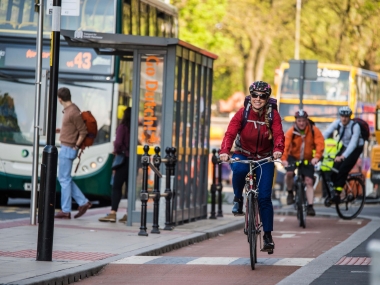Mobility: ensuring decarbonisation is at the heart of rethinking our infrastructure
Edited on
13 May 2022In the efforts to reduce carbon emissions, mobility is a key issue. Read here how our partner TfGM is promoting a more sustainable mobility model, both by favouring the shift to cleaner modes, and also reducing emissions in all vehicles.

Energy security is, understandably, in the news a lot at the moment. Protecting our energy supply is vital as people rely on it for heating, lighting and transport. Currently, the most common way to produce the energy we all use is to burn fossil fuels, and the transport sector has a huge role to play in addressing this. We need to support energy security while maximising the potential of each transport mode, and our network as a whole, to decarbonise.
Here in Greater Manchester, we have a particularly ambitious target of becoming fully decarbonised by 2038 - 12 years ahead of the UK government’s target of 2050.
Reaching this target requires the Greater Manchester Combined Authority (GMCA) - working with its partners, such as Transport for Greater Manchester (TfGM) and local councils - to trigger changes across all sections of society. One change we can make is minimising carbon emissions as we design, develop and deliver transport projects.
Here at TfGM, we are trying to understand Greater Manchester’s carbon story from different angles and rethink how we plan, design and deliver the right infrastructure that supports decarbonisation of transport. Transport Strategy’s Modelling and Analysis team have been undertaking project level carbon analysis work which will ultimately help us to calculate how much carbon a transport project - such as a new interchange, or bus corridor - will create if we go ahead with it.
The toolkit is two-fold: it considers transport projects in terms of travel behaviour change they will enable (for example, modal shift to public transport or new trip production) and embodied carbon created during construction and throughout the life of the scheme.

Scheme of TfGM’s Carbon toolkit
The carbon toolkit can be understood through the above graphic. The left-hand side of this diagram takes a ‘top down’ approach, in terms of how we evolve each year when it comes to modal, energy and fleet mix pathways. The right-hand side of diagram is focussed on a ‘bottom up’ approach, in the form of behavioural change enabled by each project.
An embodied carbon tool has been developed and is in the early stages of being tested on transport projects. One challenge in assessing embodied carbon, is that it is hard to know how many times you will need to re-build a particular section of road throughout its life.
This tool is now in need of further development. Knowing how much carbon a transport scheme produces is not an ‘optional extra’. The UK government’s own guidance (WebTAG) states that officials should know how much carbon transport schemes produce. This is arguably a piece of information that decision makers should have in their hands when developing transport infrastructure schemes. It is also acknowledged that there could be political sensitivities if a desired transport improvement scheme does not have a favourable carbon assessment.
It is also important that international conversations take place between people who make decisions about transport, whether they are elected officials or transport practitioners. If we try to ‘go it alone’ we will just export emissions. International co-operation, now more than ever, is key to getting this right.
Cover image: Bike lane and bus stop in Manchester.
 Submitted by Mikel Berra-Sandín on
Submitted by Mikel Berra-Sandín on

